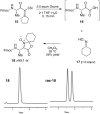Chemoselective protection of alpha-ketoacids by direct annulations with oximes
- PMID: 20356071
- PMCID: PMC2883889
- DOI: 10.1021/ol100467t
Chemoselective protection of alpha-ketoacids by direct annulations with oximes
Abstract
Oximes and alpha-ketoacids undergo an unexpectedly facile and chemoselective annulation to afford 2,5-dihydrooxazole 3-oxides. The resulting cyclic nitrones serve as chemically and configurationally stable masked alpha-ketoacids that can be easily elaborated and manipulated. Deprotection is achieved by mild reduction with zinc metal and hydrolysis. This methodology allows for the protection, elaboration, and deprotection of enantiopure peptide derived alpha-ketoacids, which are the key starting materials for the chemoselective ketoacid-hydroxylamine peptide ligation.
Figures





Similar articles
-
Nitrone protecting groups for enantiopure N-hydroxyamino acids: synthesis of N-terminal peptide hydroxylamines for chemoselective ligations.Org Biomol Chem. 2010 Aug 7;8(15):3405-17. doi: 10.1039/c004490c. Epub 2010 Jun 22. Org Biomol Chem. 2010. PMID: 20567784
-
Chemical Protein Synthesis by Chemoselective #x03B1;-Ketoacid-Hydroxylamine (KAHA) Ligations with 5-Oxaproline.Methods Mol Biol. 2021;2355:151-162. doi: 10.1007/978-1-0716-1617-8_14. Methods Mol Biol. 2021. PMID: 34386958
-
Traceless preparation of C-terminal α-ketoacids for chemical protein synthesis by α-ketoacid-hydroxylamine ligation: synthesis of SUMO2/3.Angew Chem Int Ed Engl. 2014 Nov 3;53(45):12248-52. doi: 10.1002/anie.201407014. Epub 2014 Sep 22. Angew Chem Int Ed Engl. 2014. PMID: 25244549
-
Exploration and Development of Nitrone Chemistry.Chem Pharm Bull (Tokyo). 2024;72(8):731-746. doi: 10.1248/cpb.c24-00343. Chem Pharm Bull (Tokyo). 2024. PMID: 39085089 Review.
-
Oxime ligation: a chemoselective click-type reaction for accessing multifunctional biomolecular constructs.Chemistry. 2014 Jan 3;20(1):34-41. doi: 10.1002/chem.201302426. Epub 2013 Dec 2. Chemistry. 2014. PMID: 24302514 Review.
References
-
- Cooper AJL, Ginos JZ, Meister A. Chem. Rev. 1983;83:321–358.
-
-
For recent work on the preparation of N-terminal peptide hydroxylamines, see: Fukuzumi T, Bode JW. J. Am. Chem. Soc. 2009;131:3864–3865.
-
Publication types
MeSH terms
Substances
Grants and funding
LinkOut - more resources
Full Text Sources

